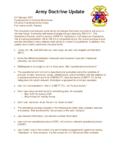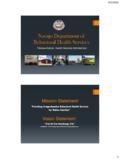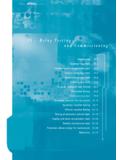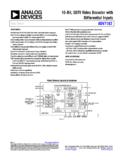Transcription of CIVIL DISTURBANCE OPERATIONS
1 FM , Department of the Army April 2005 DISTRIBUTION RESTRICTION: Approved for public release; distribution is unlimited. This publication is available at Army Knowledge Online ( ) and General Dennis J. Reimer Training and Doctrine Digital Library at ( ) i*FM (FM 19-15)Field ManualHeadquartersNo. of the Army Washington, DC, 18 April 2005 CIVIL DISTURBANCE ivChapter 1 OPERATIONAL THREATS OF THE CIVIL DISTURBANCE 1-1 General Causes for CIVIL 1-1 Crowd 1-2 Crowd Building .. 1-4 Dispersal Process of a Gathering .. 1-4 Crowd Dynamics .. 1-5 Crowd Types .. 1-6 Crowd Tactics .. 1-7 Tactics Used to Defeat Authorities .. 1-9 Weapons .. 1-9 Chapter 2 CONTROL FORCE 2-1 CIVIL DISTURBANCE Planning Considerations .. 2-1 Legal Considerations .. 2-9 Multinational OPERATIONS .. 2-12 Scalable Effects .. 2-12 Chapter 3 APPREHENSION, SEARCH, AND 3-1 Legal Considerations .. 3-1 Types of 3-2 Apprehension .. 3-3 Chapter 4 RIOT SHIELD AND RIOT BATON 4-1 Overview.
2 4-1 Riot 4-1_____Distribution Restriction: Approved for public release; distribution is unlimited.*This publication supersedes FM 19-15, 25 November FM 18 April 2005 ContentsPageRiot Baton .. 4-3 Working as a Team .. 4-21 Nonlethal Munitions .. 4-22 Chapter 5 NONLETHAL CAPABILITIES SET AND EMPLOYMENT 5-1 Personnel Protectors .. 5-1 Personnel Effectors .. 5-4 Mission Enhancers .. 5-12 Core Capabilities .. 5-20 Additional Capabilities .. 5-22 Employment 5-22 Nonlethal Weapons Capabilities in Formations .. 5-22 Chapter 6 CIVIL DISTURBANCE 6-1 Actions Before Movement .. 6-2 Rally Point 6-3 Control Force Formations .. 6-3 Extraction Team OPERATIONS .. 6-10 Lethal Overwatch Teams .. 6-11 Reserve Forces .. 6-12 Squad Formations .. 6-13 Chapter 7 CIVIL DISTURBANCE OPERATIONS IN CONFINEMENT 7-1 Crowd Dynamics Within the Confinement Facility.
3 7-1 Use of Chemical Irritants .. 7-3 Record of Events .. 7-7 Equipment .. 7-8 Riot Control 7-9 Apprehension Teams .. 7-9 Forced Cell Move Teams .. 7-12 Chapter 8 CIVIL DISTURBANCE 8-1 Unit Training Strategy 8-1 Training Plan Development .. 8-1 Range 8-2 Appendix A METRIC CONVERSION A-1 Appendix B OPERATIONS AND LEGAL CONSIDERATIONS IN THE CONTINENTAL UNITED B-1 Federal Intervention and Aid .. B-1 Roles and Responsibilities of Various B-2 State and Local Government Responsibilities .. B-3 ContentsPageiiiLegal Considerations and Constraints .. B-5 Support to CIVIL Law Enforcement .. B-9 Lead Agency Concept and Role of Military .. B-12 Appendix C URBAN TERRAIN C-1 Significant C-1 Urban Terrain Types .. C-2 Urban Form and Function .. C-5 Urban C-6 Urban Infrastructure .. C-6 Appendix D PRACTICAL D-1 Overview .. D-1 Procedures .. Index-1 18 April 2005 FM iv FM 18 April 2005 PrefaceField Manual (FM) addresses continental United States (CONUS) and outside continental United States (OCONUS) CIVIL DISTURBANCE OPERATIONS .
4 Today, United States (US) forces are deployed on peacekeeping, peace enforcement, and humanitarian assistance OPERATIONS worldwide. During these OPERATIONS , US forces are often faced with unruly and violent crowds intent on disrupting peace and the ability of US forces to maintain peace. Worldwide instability coupled with increasing US military participation in peacekeeping and related OPERATIONS requires that US forces have access to the most current doctrine and tactics, techniques, and procedures (TTP) necessary to quell riots and restore public addition to covering CIVIL unrest doctrine for OCONUS OPERATIONS , FM addresses domestic unrest and the military role in providing assistance to CIVIL authorities requesting it for CIVIL DISTURBANCE OPERATIONS . It provides the commander and his staff guidance for preparing and planning for such OPERATIONS . The principles of CIVIL DISTURBANCE OPERATIONS , planning and training for such OPERATIONS , and the TTP employed to control CIVIL disturbances and neutralize special threats are discussed in this manual.
5 It also addresses special planning and preparation that are needed to quell riots in confinement facilities are also the past, commanders were limited to the type of force they could apply to quell a riot. Riot batons, riot control agents, or lethal force were often used. Today, there is a wide array of nonlethal weapons (NLW) available to the commander that extends his use of force along the force continuum. This manual addresses the use of nonlethal (NL) and lethal forces when quelling a A complies with current Army directives, which state that the metric system will be incorporated into all new proponent for this publication is HQ, TRADOC. Send comments and recommendations on Department of the Army (DA) Form 2028 (Recommended Changes to Publications and Blank Forms) directly to Commandant, US Army Military Police School (USAMPS), ATTN: ATSJ-DD, 401 MANSCEN Loop, Fort Leonard Wood, MO this publication states otherwise, masculine nouns or pronouns do not refer exclusively to April 2005FM 1 Operational Threats of the CIVIL DISTURBANCE EnvironmentAs the Cold War ended with the fall of the Berlin Wall and the collapse of Soviet communism in 1989, the Army was no longer concerned with containing the aggressive Soviet Union.
6 The US Army began to transform because the battlefield on which it would fight had changed. OPERATIONS Just Cause, Joint Endeavor, Desert Shield, and Desert Storm have all been recognized as containing nontraditional battlefields. Following these OPERATIONS , the Army was called upon to conduct peacekeeping, peace enforcement, and humanitarian assistance OPERATIONS . These OPERATIONS required US forces to protect refugees and humanitarian workers and keep hostile factions separate to enforce peace. GENERAL CAUSES FOR CIVIL UNREST1-1. In these modern times, demonstrations, CIVIL unrest, public disorder, and riots happen for a number of reasons. Some of these reasons are economic hardships, social injustices, ethnic differences (leading to oppression), objections to world organizations or certain governments, political grievances, and terrorist acts. An event can be triggered by a single cause or a combination of causes. For example, OPERATIONS in the Balkans involving CIVIL unrest and riots were the result of ethnic hatred, a lack of CIVIL authority, food shortages, a revolution, and religious-based fighting Demonstrations may range from simple, nonviolent protests that address specific issues, to events that turn into full-scale riots.
7 Gatherings in protest are recognized rights of any person or group, regardless of where US forces may be operating. This fundamental right is protected under the Constitution of the US. During peacekeeping or peace enforcement OPERATIONS , US forces should never violate basic CIVIL or human rights. Most protesters are law-abiding citizens who intend that their protests be nonviolent, but some protest planners insist that the event involve some kind of violence. Often, in the media, protesters can gain sympathy for their cause by prompting authorities to take physical action against them. Violence is often the result of demonstrators beginning to conduct unlawful or criminal acts and authorities (who are responsible for the safety and welfare of all) enforcing the laws of the municipality, state, or nation. The depth of violence is determined by the willingness of demonstrators to display and voice their opinions in support of their cause. 1-3. Commanders must be aware of the possibility that some individuals or groups within an organized demonstration may have the intent to cause disruption, incite violence, destroy property, and provoke the authorities.
8 The tactical situation and actions of the crowd should dictate control and enforcement options. Agitators and criminal infiltrators within the crowd can Operational Threats of the CIVIL DISTURBANCE Environment1-2FM April 2005lead to the eruption of violence. Inciting a crowd to violence or a greater intensity of violence through the use of brutish enforcement tactics should be avoided. Publicity can be detrimental to authorities and beneficial to crowds because it can further their Community unrest results in urban conflicts that arise from highly emotional social and economic issues. Economically deprived inner city residents may feel that they are treated unjustly or ignored by people in power and authority. Tensions can build quickly in a community over a variety of issues, such as hunger, poor employment opportunities, inadequate community services, poor housing, and labor issues. Tension in these areas creates the potential for violence. When tensions are high, it takes a small (seemingly minor) incident, rumor, or act of injustice to ignite groups within a crowd to riot and act violently.
9 This is particularly true if community relations with authorities are part of the Significant ethnic differences in a community can create an atmosphere of distrust, even hatred. Unrest among ethnic groups competing for jobs, living areas, and sparse essentials can cause an eruption of CIVIL disorder and/or riots. As emotions run high, violence becomes Terrorist organizations may infiltrate groups within a demonstrating crowd. These terrorist groups may intend to embarrass their government or other governments. Terrorist infiltrators can be used to provoke crowds as a diversion, as part of a demonstration, or as cover for terrorist acts. CROWD DEVELOPMENT1-7. Crowds are a gathering of a multitude of individuals and small groups that have temporarily assembled in the same place. These small groups are usually comprised of friends, family members, or acquaintances that represent a group belief or cause. Individuals assume a sense of anonymity they are viewed as just another face in the crowd.
10 People in small groups are known only to companions in their group and to others in the gathering that have come from the same neighborhood or community. Commanders must consider how the individuals assembled and how they are interacting during the gathering The assembly process of a gathering refers to the movement of people from different locations to a common location within a given period. This largely determines who participates. Creating a gathering from a crowd is a process with a beginning, middle, and end. As shown in Figure 1-1 a crowd has an assembly process that leads to the gathering of the crowd, which is always followed by a dispersal Gatherings are often assisted by the activities of individuals or groups with a specific agenda, such as yelling catchy slogans and cheers that everyone can easily pick up and join in on. Some groups are so well organized that they can prestage leaders to infiltrate a gathering. This creates unity, 18 April 2005FM Threats of the CIVIL DISTURBANCE Environmenteven inciting newcomers to join their cause.
















